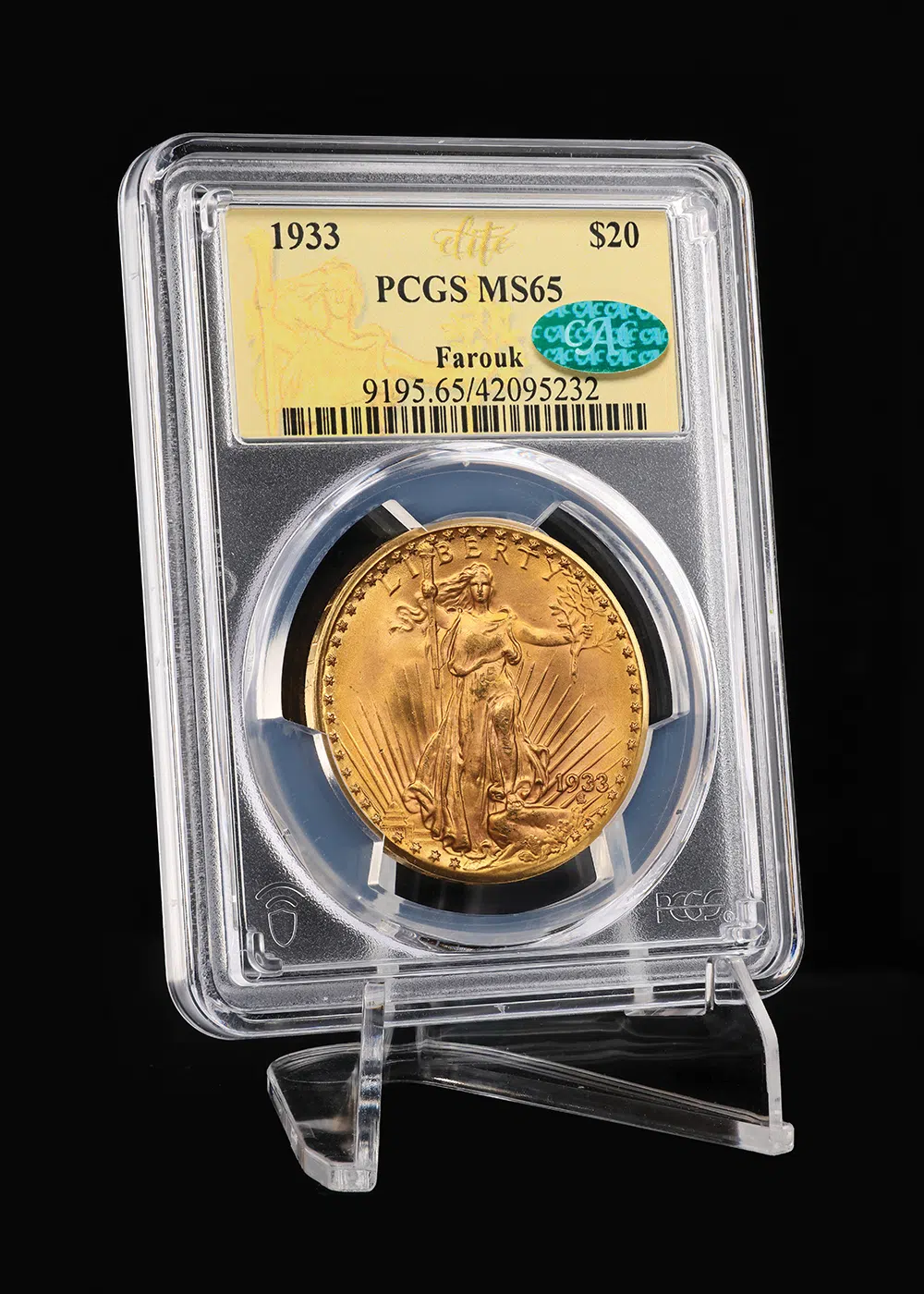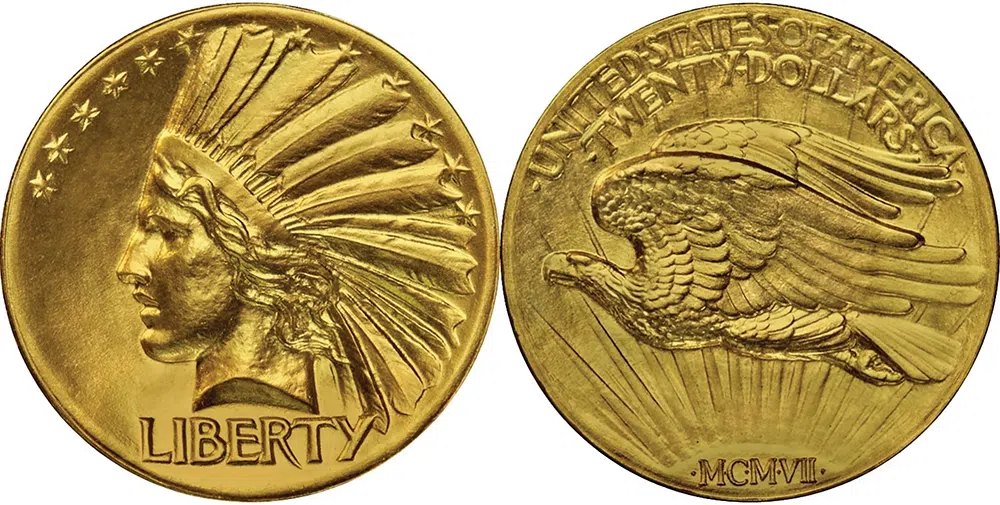
1933 Saint-Gaudens Double Eagle
How can a coin that was intended for circulation and had a mintage of 445,500 coins be the world’s most expensive gold coin? It is a story about timing, a gift, a theft, and our nation’s economic history.
In 1933, America was battling the effects of the Great Depression. The stock market had crashed in 1929, which financially ruined thousands of investors and caused billions of dollars to vanish. Unemployment topped 20% in 1933 and soup kitchens were commonplace. There were no financial safety nets then. So there was no FDIC to insure bank deposits and there were no unemployment programs or Social Security to protect Americans.

Herbert Hoover, Franklin D. Roosevelt and the Ban of Gold Ownership Herbert Hoover was President of the United States during a number of these events and when he ran for reelection in 1932, America desperately wanted a change. Franklin D. Roosevelt was overwhelmingly elected and he began to implement programs to help out-of-work Americans.
One of Roosevelt’s earliest plans was for America to stop using gold to back the value of the U.S. dollar. Roosevelt explained: “The free circulation of gold coins is unnecessary, leads to hoarding and tends to a possible weakening of national financial structures in times of emergency.” The U.S. dollar did drop, initially against European-gold based currencies. Since no gold coins were circulating, no one could hoard these coins and weaken the value of the dollar.

Now that the United States Mint would no longer be striking gold coins, coins that were in circulation were being recalled. The coins that were turned in by citizens were melted and turned into gold bars.
The identity of the 2002 buyer was kept private until March 2021, when it was revealed that the owner was shoe magnate Stuart Weitzman.”
The 1933 Saint-Gaudens Double Eagles were also supposed to be melted, but some 22 coins escaped the crucible. Two were ordered to be saved by the government and placed in the National Coin Collection at the Smithsonian Institution and 20 somehow were stolen. Since these 1933 Saint-Gaudens coins were never officially authorized, it was now, ostensibly, illegal to own one.
Tracing 1933 Saint-Gaudens Double Eagles
George McCann, head cashier at the Philadelphia Mint, apparently replaced 20 of the 1933-dated specimens with 20 other Double Eagles, all of which were supposed to be melted.
Those coins were obtained by Israel Switt, a Philadelphia jeweler. Over time, Switt sold the coins to a number of collectors and coin dealers until only nine were left, and those were in a family safe deposit box. But of the 11 coins that were sold, suspicion arose as the coins individually came up for auction from various parties.

Coin Dealer B. Max Mehl had sold a 1933 Saint-Gaudens Double Eagle to King Farouk of Egypt before anyone in the government knew that the coins had been stolen. The Smithsonian Institution authorized the coin to be sent to King Farouk, and it was sent.
After Farouk died, the government of Egypt selected Sotheby’s auction house to sell his treasures, which included the 1933 Saint-Gaudens Double Eagle, but just before the auction it was withdrawn.
It was not until the 1990s when it resurfaced. Dealings between dealers and collectors later kept the coin under the radar until 2002. The government recovered the coin, but the dealer who purchased it was able to point to the fact that the Farouk-pedigreed coin had been issued an export license and was, therefore, legal to own. The U.S. Government’s position, however, was that the coin had originally been stolen. The U.S. Government and the dealer came to a historic agreement that the coin could legally be sold at auction, with the proceeds split between the dealer and the government.

On July 30, 2002, the 1933 Saint-Gaudens Double Eagle was sold at public auction to a private collector. The hammer price was $6.6 million dollars, plus a 15% buyer’s premium and an additional $20 to the United States Mint to monetize the coin.
The 1933 Saint-Gaudens Double Eagles were also supposed to be melted, but some 22 coins escaped the crucible. Two were ordered to be saved by the government and placed in the National Coin Collection at the Smithsonian Institution, and 20 somehow were stolen.”
Who Bought the 1933 Saint in 2002?
The identity of the 2002 buyer was kept private until March 2021, when it was revealed that the owner was shoe magnate Stuart Weitzman. His decision to reveal that he owned the coin was based on his decision to sell it. The coin was delivered to the Professional Coin Grading Service (PCGS) for authentication and grading before it was sold. PCGS graded it Mint State 65 and added the “Farouk” pedigree, authenticating the provenance as having been the specimen belonging to King Farouk of Egypt. It was sold in a Sotheby’s auction on June 8, 2021, for the sum of $18,872,250.00.

Ian Russell, president of Great-Collections, a major numismatic online auction house, received permission from the new owner to bring this most valuable coin to the American Numismatic Association’s World’s Fair of Money, held in Rosemont, Illinois, in August 2021.
Russell stated: “The new owner told me that when this coin was previously sold at auction in 2002 for a then-record-breaking $7.5 million, he was determined to one day own it. Nineteen years later, he fulfilled his dream.” Russell also said: “The coin is currently in the finest set of Saint-Gaudens Double Eagles—the Elite Collection. It’s featured on the cover of the latest 100 Greatest U.S. Coins, by Jeff Garrett and Ron Guth, and appropriately listed as the Number One coin in that book.”
“We are aiming to display it at a major show in 2025,” Russell noted. He brought the coin and discussed it with Rick Harrison of the History Channel’s TV show “Pawn Stars” where this gold coin became the star of that episode.

Contenders for the ‘Most Valuable Coin’ Title The 1933 Saint-Gaudens Double Eagle has sold at public auction for nearly $20 million, and some speculate in today’s market it could be worth $30 million. But is it the most valuable coin of all time? There are possibly a couple of other contenders for that coveted “most valuable” title.
One extremely rare coin is the 1907 $20 Indian Head gold pattern, listed as Judd-1776. The coin is possibly unique, and it is unusual in that it displays on the obverse, or front, of the coin Ms Liberty in an Indian-style headdress, which was the accepted design for the Indian Head Eagle gold coin struck between 1907 and 1933. The reverse is similar to the accepted Saint-Gaudens Double Eagle depicting an American Eagle in flight.
Whatever the most valuable coin may be today, the 1933 $20 Saint-Gaudens Double Eagle has established itself as possibly the front-runner if and when it is sold again.”
This pattern coin last came to auction in 1981 in a Bowers and Ruddy sale where it sold for $475,000. The PCGS estimated grade of that coin today would be Proof-69, and my possible estimate of its value is $15 million or more if auctioned.

Another contender for that elusive “most valuable” crown is a 1794 Flowing Hair Silver Dollar with silver plug, graded Specimen-66. The coin is believed by some to be one of the first coins of this type to be manufactured from those dies. Some experts argue that it is indeed the first coin struck.
This unfathomably gorgeous 1794 Silver Dollar came up for auction in 2013 at a Stack’s Bowers auction, where it brought $10,016,875.

There are numerous other coins that are often mentioned as candidates for possibly the most expensive coin of all time, and they are:
•1804 Draped Bust Silver Dollar, large eagle, original class 1, Proof 68, sold for $7,680,000 in 2021.
•1913 Liberty Nickel in Proof 64, only five coins known to exist, the “Hawaii 5-0” TV program specimen sold for $3,290,000 in 2014.

•1894-S Barber Dime, 24 manufactured by the mint, but only nine are known to exist. A Branch Mint Proof graded Proof 66 from the Eliasberg Collection brought $2 million when it was sold by Heritage Auctions in 2016.
•1787 Gold Brasher Doubloon, EB on wing, NGC graded MS65 Star, last sold in 2021 at a Heritage Auction for $9,360,000.
Whatever the most valuable coin may be today, the 1933 $20 Saint-Gaudens Double Eagle has established itself as possibly the front-runner if and when it is sold again.
It may break all existing records, as there is only one coin that will ever be available for legal sale.










